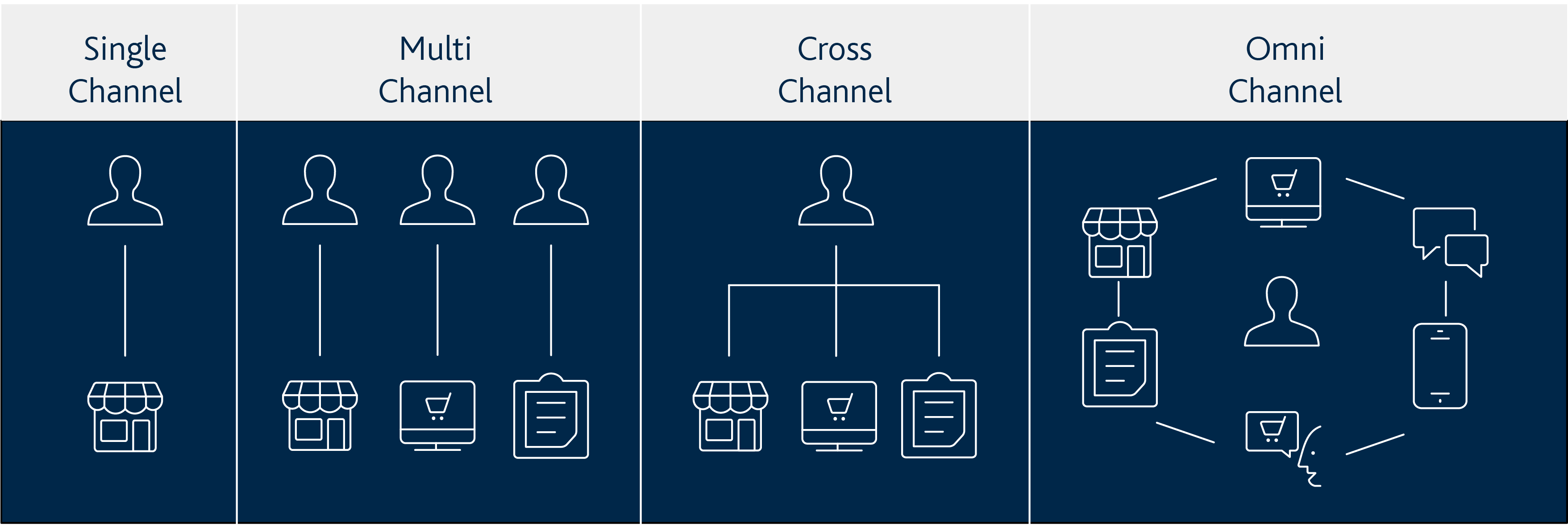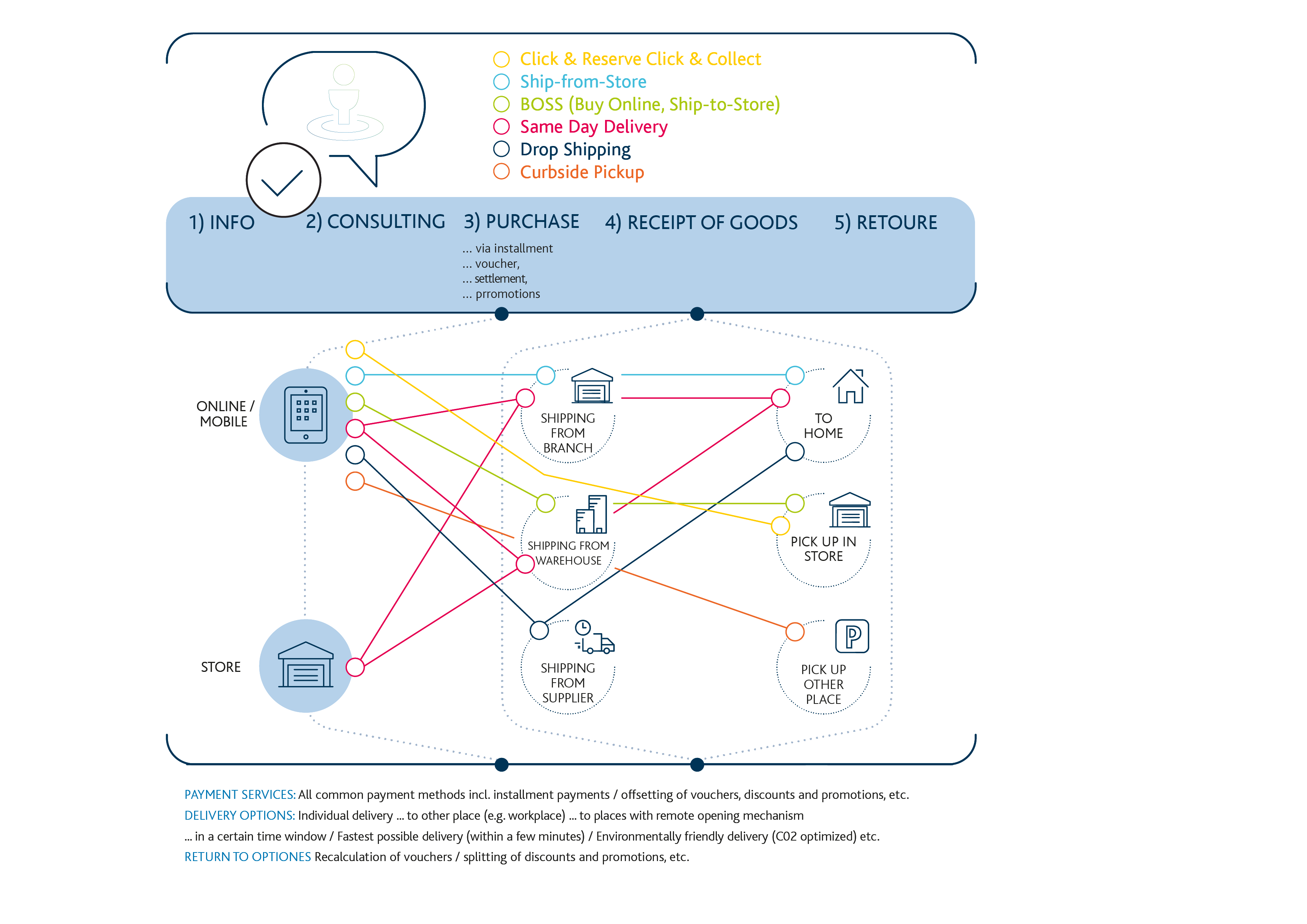
Trade in Transition
Omnichannel services explained in an understandable way
The pandemic at the latest has shown that retail urgently needs to increase its resilience. The omnichannel approach offers an opportunity here. It creates the basis for a variety of customer-attractive services such as click and collect, BOPIL, ship-to-store and others. The broad spectrum is confusing - we create clarity.
Large parts of the trade were shut down as part of the Corona pandemic. In this context, the term click and collect also appeared in the popular press: A way for retailers to at least somewhat mitigate the loss of sales caused by the lockdown.
This also made a broader public aware that retail continues to undergo a profound transformation. Whereas e-commerce was previously perceived almost exclusively as competition for bricks-and-mortar retail, the advantages of networking traditional and electronic retail channels are now being widely recognized by consumers.
In fact, the business transformation in retail is far from complete, and it also affects online retail. In view of the rapid development with ever new strategies and services, it is easy to lose one's bearings - time for some explanations of terms.
Evolutionary stages of electronic commerce

-
Singlechannel
As the name suggests, in this model products are only sold via one channel - either the classic retail store or a web store. Online or not - this form of retailing has had its day.
-
Multichannel
This approach goes one step further - customers can shop via multiple channels, be it brick-and-mortar retail, online, or even via a mail-order catalog. However, the channels are not linked and act completely independently of each other. Again, this approach will hardly give you any real chance of success today.
-
Crosschannel
This model not only offers multiple sales channels, but also networks them with each other. Retailers can synchronize their offers across all channels, and customers can combine the channels with each other - one example is the aforementioned click and collect. What is missing is the all-round view of the customer and the complete and transparent networking of all channels.
-
Omnichannel
This is the freestyle in modern commerce. Stores, central warehouse, online store, social media, mobile commerce, voice commerce (i.e., voice-assisted shopping via voice assistants such as Amazon Alexa, Apple Siri, or Google Assistant) - everything is connected to everything else transparently, permanently, and in real time. The shopping experience is consistently synchronized across all channels and according to the respective usage situation of the customer.
-
Unified commerce
This is omnichannel commerce, in which the sales channels with their different systems are not only networked, but a central backend platform brings together all data and processes in real-time. This creates an optimal customer experience and the shopping experience is seamless.
Customer Focus
A key feature of omnichannel is the absolute focus on the consumer perspective (Customer Service) based on comprehensive information about customer behavior. The goal of this effort is to support customers in the exact situation and state of mind from which they make purchases.
Today, this may be from home or on the move via PC, voice assistant, smartphone, or tablet; tomorrow, they may prefer brick-and-mortar retail due to the situation, or they may flexibly combine the channels - whatever is most convenient or useful for them at the moment.
One challenge here is to implement omnichannel processes efficiently and economically.
New forms of service increase resilience
The omnichannel approach enables retailers to offer a wide range of new services. The primary purpose of these services is to meet customers in their particular shopping situation and thus to reflect customer behavior. This increases customer satisfaction and loyalty.
However, many of the services described here offer opportunities to maintain at least a rump business, especially in the current situation (demand for a reduction in contacts):

-
Click and Collect
This service is often also referred to as BOPIS - "Buy Online, Pickup In Store". Customers search for items in the online store and are informed in which store they are available. They complete the order, including payment, online and select the "Pickup in Store" delivery method. In the process, the retailer can also offer its customers the option of specifying a time window for pickup - this makes planning easier for the store in question.
-
Curbside Pickup
This offer is equivalent to click and collect, but the goods ordered and paid for online are issued via a car counter - basically drive-in retail.
-
BOPIL
The abbreviation stands for "Buy Online, Pickup In Locker". This process is also similar to the Click and Collect method, but the products can be picked up via a locker. Together with the order confirmation, customers receive a code that can be used to open the locker. The process is familiar in Germany from car rental companies, for example, which deposit car keys and papers in the locker.
-
BOSS
The catchy abbreviation stands for "Buy Online, Ship-from-Store". Products ordered centrally online are shipped to customers from the store where they are currently in stock. This supports the sale of goods in the individual stores.
-
Ship-to-Store
If a product is not available at the customer's preferred store, it is delivered to that store from another retail location or a distribution center. This does not necessarily shorten the delivery time, but this shipping option is usually free of charge. One advantage for the retailer is that it reduces the load on the central warehouse.
-
ROPIS
The abbreviation stands for "Reserve Online, Pickup In Store" - in other words, reserving products online at a store and then picking them up there. This gives customers confidence that their visit to the store will not be unsuccessful. The process is also useful in the fashion sector, for example, as customers can still try on the goods when they visit the store. This reduces the time-consuming and costly returns that are very common with online orders.
-
BORIS
This abbreviation describes the "Buy Online, Return In Store" principle. Customers can return goods ordered online to a store if they are not satisfied. This creates more flexibility for customers and increases frequency in the store with the chance of exchange business. If the retailer offers free returns in online retailing, the cost of returns is also reduced.
-
Dropshipping
This refers to the delivery of products ordered from the retailer via their manufacturer. The process is ideal for bulky items and for seasonal and low-turnover goods. It enables retailers to significantly reduce their warehousing costs. However, the logistical effort involved is not inconsiderable - after all, the approach must be possible for all ordering channels and the systems of the retailer and manufacturer must be integrated.
More about Dropshipping -
Endless Aisle
This concept enables customers in stationary retail to order products not stocked in the store there and have them delivered to their homes. This allows the retailer to expand its product range without burdening warehouse management. The process is ideal, for example, for large products or those with low order volumes. The order is usually placed via a special online portal offered in the store. Retailer employees can advise customers on product selection. Delivery then takes place either via a central warehouse of the retailer or, in combination with the dropshipping process, directly via the manufacturer of the respective product.
Effective Order Management is mandatory
The smooth processing of such services stands and falls with the efficient and secure management of inventories and orders (distributed order management) - for each individual order, it must be clear when which products have to be available where for collection by customers or dispatch.
All these services therefore require the transparent dovetailing of long-established processes in retail stores with e-commerce systems and numerous new processes and systems.
In principle, the required functionalities can be mapped using existing systems such as ERP and CRM systems, warehouse management or even checkout systems. However, it should be noted that the resulting IT environment will be very complex and the maintenance of functionalities and data will remain costly. More on the topic of "Simplified IT Architecture".
This means that offering omnichannel services will have an impact on the contribution margin and thus on profitability. Many retailers put a good face on the matter and accept this.
A powerful order management system, or OMS for short, such as aroma® from Arvato Systems, can provide a remedy. Such a solution is the "single point of truth" for managing all orders and their changes. Based on the data from the OMS, all related processes are controlled efficiently and securely.
In this way, the order management solution enables retail companies to offer comprehensive omnichannel services with a lean system without compromising profitability.
Your Contact for Omnichannel Services







